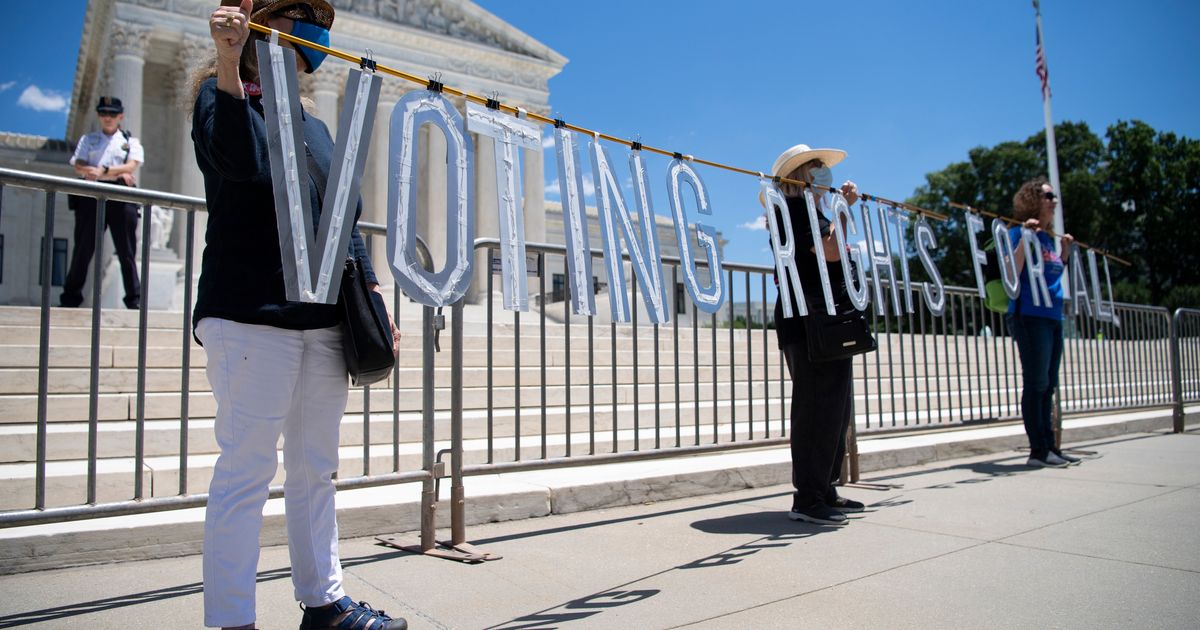Just months after the Supreme Court upheld a key section of the Voting Rights Act and ordered Alabama to draw a second Black-plurality congressional district, it will hear another challenge on Wednesday arguing that yet another Southern state’s district map is racially discriminatory.
In Alexander v. South Carolina State Conference of the NAACP, Black South Carolinians alleged that the state is diluting Black voters’ power in an effort to increase GOP representation in Congress. A three-judge federal district court panel agreed, ruling in January that the congressional district map adopted in 2022 by South Carolina’s Republican government violated the 14th Amendment’s protection against racial discrimination by “bleaching … African American voters out of the Charleston County portion of [the 1st Congressional District].”
This case is different from the Alabama-centered case the Supreme Court decided in June, Allen v. Milligan. Then, state Republicans sought to overturn decades of Voting Rights Act precedent by asking the court to adopt a race-blind approach to judging cases of racial discrimination brought under the act. In South Carolina, the challenge runs through the Constitution’s 14th Amendment’s equal protection clause, which forbids race-conscious redistricting in which race is used as a predominant factor when states draw congressional districts.
The case is the latest in a string of redistricting cases making their way through the federal courts following the 2020 census. In drawing new maps, Republicans in state legislatures across the country pushed past the boundaries set by the Voting Rights Act and the 14th Amendment to reduce the political power of racial minorities. They did so with the belief that the court’s six-vote conservative supermajority was willing to toss aside precedent to affirm maps favorable to Republicans.
Alabama’s effort to rewrite the Voting Rights Act failed at the Supreme Court. South Carolina’s bid to get the court to ratify its alleged racial gerrymander will have consequences for similar cases rooted in the 14th Amendment, like one out of Florida that is still moving through lower courts.
Jeffrey Collins via Associated Press
One thing that may prove problematic for South Carolina is that the conservative justices, while often hostile to voting rights claims and charges of racial discrimination, are also opposed to race-conscious policy-making. And here the charge is that Republicans engaged in race-conscious redistricting in order to excise Black voters from one congressional district.
“The claim that [South Carolina was] sorting based on race should concern the conservative justices,” said David Cole, national legal director for the American Civil Liberties Union, which is one of three parties arguing on behalf of Black South Carolinians in the case.
Unlike Alabama in Allen, South Carolina is not directly challenging Supreme Court precedent. The state’s Republican leadership simply argues that race was not a major factor when it redrew the boundaries of the 1st Congressional District, in and around Charleston. The Black South Carolinians, however, argue that the legislature engaged in race-conscious redistricting when it drew the district’s lines.
That district, encompassing Charleston and its suburbs, has been won by a Republican in every election since 1980, save for 2018, when it sent Democrat Joe Cunningham to Congress. The district became more competitive as college-educated white voters swung towards Democrats following Donald Trump’s ascendancy in the Republican Party. The current congresswoman, Republican Rep. Nancy Mace, eked out a 1% win over Cunningham in 2020.
Following the 2020 census, Republicans redrew the district to more heavily favor their own party. They removed 62% of the district’s Black population, which votes for Democrats at a rate of about 90%, and placed them in the 6th District, held by Democratic Rep. James Clyburn, the state’s lone Black congressman. Mace went on to win reelection in the new 1st District by 14%.
South Carolina Republicans don’t contest that they gerrymandered the district to favor themselves. Instead, they argue in their brief to the court that they moved the Black voters out of the district “based on their political composition and traditional criteria, not their racial composition.” (Traditional criteria may include factors like not disrupting a district’s compactness, contiguity or existing communities of shared interest.) Admitting to a political motive is a safe bet: In a 2019 ruling, the Supreme Court stated that it would no longer hear challenges to partisan gerrymandering.
To win a 14th Amendment racial gerrymandering case, the challengers need to show that race predominated as a factor in how the maps were drawn. In this case, they note that Republicans set an artificial 17% maximum for the Black voter population in the district. An expert conducted a series of computer simulations on behalf of the challengers, demonstrating that maps based on traditional redistricting criteria could not replicate the 17% Black voter threshold without taking race into account.

Michael Ciaglo via Getty Images
Republicans chose a 17% Black voting population limit after the National Republican Redistricting Trust, an advisory group, showed that “a district in the range of 17% African American produced a Republican tilt, a district in the range of 20% produced a ‘toss up district,’ and a plan in the 21-24% range produced a Democratic tilt,” according to the three-judge district court panel.
Similarly, the state’s mapmaker testified that he “abandoned” his initial effort to make the “least change” to the district and opted for “dramatic changes” that created a “tremendous disparity” in the district’s Black population. The 1st District was the only district in the state where the mapmaker departed from making the “least change.” At least eight witnesses testified to the district court panel that Republicans used race in drawing the district’s lines as a way to gerrymander their preferred partisan result.
“The case involves a straightforward application of the court’s 2017 decision in Cooper v. Harris, which held that race cannot be used as a proxy for political behavior,” said Sophia Lin Lakin, head of the ACLU’s Voting Rights Project.
That case was decided by a 5-4 vote, with conservative Justice Clarence Thomas joining the then-four liberal justices in the majority. But the conservatives now enjoy a six-vote supermajority following the death of Ruth Bader Ginsburg in 2020. Black South Carolinians will need to convince at least two conservatives to join the three liberals if they hope to win.
A victory at the Supreme Court would also have major political ramifications: A 1st Congressional District with a higher Black voter population would become at least competitive if it doesn’t tilt towards Democrats. And, in turn, a partisan shift in any single district has massive ramifications for Republicans’ ability to hold on to their teetering five-vote House majority in the 2024 elections.

